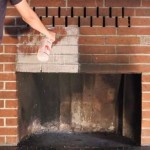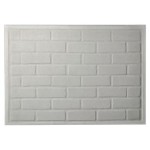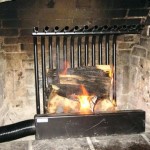How To Clean Gas Fireplace Logs
Gas fireplaces offer the ambiance of a traditional wood-burning fireplace without the mess and inconvenience. However, these fireplaces require regular cleaning to maintain their appearance and ensure optimal performance. The logs, in particular, can accumulate soot and dust over time, diminishing their aesthetic appeal and potentially affecting the efficiency of the gas burner. This article provides a comprehensive guide on how to safely and effectively clean gas fireplace logs, preserving the beauty and functionality of the fireplace.
Prior to commencing any cleaning activities, it is imperative to prioritize safety. The gas supply to the fireplace should be completely shut off. This can typically be achieved by locating the gas valve, often situated near the fireplace or in an adjacent utility area, and turning it to the "off" position. Furthermore, ensure that the fireplace is completely cool to the touch. Attempting to clean the logs while they are still hot poses a significant burn risk. Wearing appropriate protective gear, such as gloves and a dust mask, is also recommended to prevent skin irritation and inhalation of soot or dust particles.
Preparing the Cleaning Area and Gathering Supplies
Effective cleaning begins with proper preparation. The immediate area surrounding the fireplace should be protected to prevent the spread of soot and debris. Lay down a drop cloth or old newspapers to cover the floor and any nearby furniture. This will facilitate easier cleanup later. Next, gather the necessary cleaning supplies. These typically include a soft-bristled brush, a vacuum cleaner with a hose attachment, a clean, dry cloth, and a mild detergent specifically designed for cleaning fireplace components. Avoid using harsh chemicals or abrasive cleaners, as these can damage the delicate finish of the gas logs.
A specialized fireplace log cleaner can be beneficial for removing stubborn soot deposits. Ensure that any cleaning product used is compatible with the specific type of gas logs installed in the fireplace. Consulting the manufacturer's instructions is always advisable to avoid inadvertently damaging the logs. The vacuum cleaner with the hose attachment is critical for removing loose debris and soot before attempting any wet cleaning methods. The soft-bristled brush will be used to gently loosen any remaining deposits.
Proper ventilation is also important. Open windows or doors to ensure adequate airflow in the room. This will help to dissipate any dust or fumes that may be released during the cleaning process. If the fireplace is in a poorly ventilated area, consider using a fan to improve air circulation.
Removing and Inspecting the Gas Fireplace Logs
Carefully remove the gas logs from the fireplace. It is crucial to remember the original arrangement of the logs, as this is essential for proper burner function and aesthetics. Before removing any logs, take a photograph of the arrangement or create a simple diagram. This visual aid will be invaluable during the reassembly process. When handling the logs, do so with care, as they can be fragile and prone to chipping or breaking. Place the removed logs on the prepared drop cloth or newspaper.
Once the logs are removed, conduct a thorough inspection. Look for any signs of damage, such as cracks, chips, or excessive wear. Note any areas where soot accumulation is particularly heavy. Examine the burner assembly for any blockages or debris. Clear any obstructions that may be affecting the gas flow. If any significant damage is detected on the logs or burner assembly, consider contacting a qualified fireplace technician for repair or replacement.
Photographing individual logs after removal can also be helpful. These images can be used as a reference point during the cleaning process, allowing for a more precise and targeted approach. Detailed inspection allows for a more informed decision on the cleaning method and the types of products to use.
Cleaning the Gas Fireplace Logs: A Step-by-Step Guide
With the logs removed and inspected, the cleaning process can begin. First, use the vacuum cleaner with the hose attachment to remove loose dust and soot from the logs. Pay particular attention to crevices and textured surfaces where debris tends to accumulate. Gently vacuum each log, ensuring that all loose particles are removed.
Next, use the soft-bristled brush to gently loosen any remaining soot or deposits. Avoid applying excessive pressure, as this can scratch or damage the logs. Work in small sections, brushing away any loosened debris. For stubborn stains, a mild detergent solution may be used. Dilute the detergent with water according to the manufacturer's instructions. Dampen the clean cloth with the detergent solution and gently wipe the affected areas. Avoid soaking the logs, as excessive moisture can damage them.
If using a specialized fireplace log cleaner, follow the manufacturer's instructions carefully. Apply the cleaner to the affected areas and allow it to sit for the recommended amount of time. Then, use a clean, damp cloth to wipe away the cleaner and any remaining soot. Ensure that all traces of the cleaner are removed before reassembling the fireplace. After cleaning, allow the logs to air dry completely before placing them back into the fireplace. This prevents moisture from interfering with the gas burner and ensures optimal performance.
The frequency of cleaning depends on the usage of the fireplace. For fireplaces used frequently, cleaning may be required every few months. For fireplaces used less often, cleaning may only be necessary once a year. Regular cleaning not only maintains the aesthetic appeal of the fireplace but also helps to prevent potential issues with the gas burner.
Cleaning the Fireplace Interior
While the logs are removed, it is also an opportune time to clean the interior of the fireplace. Vacuum the firebox to remove any loose debris, ash, or soot that may have accumulated. Inspect the burner assembly for any obstructions or damage. Use a soft brush or a specialized burner cleaning tool to clear any blockages in the burner ports. Ensure that the pilot light assembly is clean and free from debris.
Examine the glass door, if applicable. Clean the glass with a glass cleaner specifically designed for fireplaces. Avoid using abrasive cleaners, as these can scratch the glass. Wipe the glass clean with a soft cloth. Check the seals around the glass door for any signs of damage. Replace any damaged seals to ensure a proper seal and prevent gas leaks.
The area surrounding the fireplace, including the hearth and mantel, should also be cleaned. Dust and wipe down these surfaces to remove any accumulated soot or debris. Use a mild detergent solution to clean any stains or spills. Ensure that all surfaces are thoroughly dry before replacing any decorations or accessories.
Reassembling the Gas Fireplace Logs
Once the logs are completely dry and the fireplace interior has been cleaned, the logs can be reassembled. Refer to the photograph or diagram that was created prior to removing the logs. Carefully place the logs back into their original positions. Ensure that the logs are arranged in a manner that allows for proper gas flow and burner function. Avoid obstructing the burner ports with the logs.
Double-check the arrangement of the logs to ensure that they are positioned correctly and aesthetically pleasing. If necessary, make minor adjustments to the arrangement to achieve the desired look. Once the logs are in place, inspect the burner assembly to ensure that it is functioning properly. Turn on the gas supply and ignite the fireplace. Observe the flame pattern to ensure that it is consistent and even. If any issues are detected, such as uneven flames or gas leaks, immediately turn off the gas supply and contact a qualified fireplace technician.
After reassembling the fireplace, dispose of the used cleaning supplies and the drop cloth or newspaper in a safe and responsible manner. Thoroughly clean the cleaning area to remove any remaining soot or debris. Wash any used cloths or brushes to prevent the spread of soot. By following these steps, the gas fireplace logs can be cleaned safely and effectively, prolonging their lifespan and maintaining their aesthetic appeal.
Maintaining Your Gas Fireplace for Longevity
After a thorough cleaning, implementing routine maintenance practices ensures the continued optimal performance and longevity of the gas fireplace. Regular inspections are crucial. Visually inspect the logs, burner assembly, and surrounding area for any signs of damage, wear, or debris accumulation. Address any issues promptly to prevent them from escalating into more significant problems.
Annual professional servicing is highly recommended. A qualified fireplace technician can perform a comprehensive inspection and cleaning, identifying any potential issues that may not be readily apparent. The technician can also check the gas lines and connections for leaks, ensuring that the fireplace operates safely and efficiently. Professional servicing helps to maintain the warranty on the fireplace and prevents costly repairs down the line.
Educating oneself on the specific model and its maintenance requirements is essential. Consult the owner's manual for detailed instructions on cleaning, inspection, and maintenance. Adhering to the manufacturer's recommendations ensures that the fireplace is properly cared for and that the warranty remains valid. Proper ventilation, regular cleaning, and prompt attention to any issues will extend the lifespan of the gas fireplace and allow for continued enjoyment of its ambiance and warmth.

How To Clean A Gas Fireplace The Proper Way

How To Gas Log Cleaning Blog Fireplace And Chimney Authority

How To Clean Gas Logs 10 Steps With S Wikihow

How To Clean A Gas Log Fireplace Ina Comfort Air

Why Is It Important To Get My Gas Fireplace Logs Clean Regularly

How To Clean Gas Logs 10 Steps With S Wikihow

How To Clean Gas Fireplace Logs Steps The Flame Company

How To Clean Soot From A Gas Log Set Full Service Chimney

How To Clean A Gas Fireplace The Proper Way

How To Clean Gas Logs 10 Steps With S Fireplace Indoor Natural








